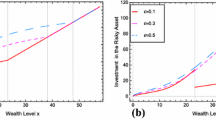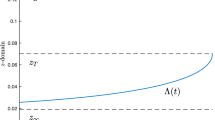Abstract
We study an optimal investment, consumption-leisure and voluntary retirement problem for an agent whose consumption rate process is subject to a subsistence constraint before retirement. We use the dynamic programming method to obtain closed-form solutions for the optimal strategies as well as the value function when the agent’s utility of consumption and leisure is of Cobb–Douglas form.




Similar content being viewed by others
References
Barucci, E., Marazzina, D.: Optimal investment, stochastic labor income and retirement. Appl. Math. Comput. 213, 5588–5604 (2012)
Chai, J., Horneff, W., Maurer, R., Mitchell, O.S.: Optimal portfolio choice over the life cycle with flexible work, endogenous retirement, and lifetime payouts. Rev. Financ. 15, 875–907 (2011)
Choi, K.J., Shim, G.: Disutility, optimal retirement, and portfolio selection. Math. Financ. 16, 443–467 (2006)
Choi, K.J., Shim, G., Shin, Y.H.: Optimal portfolio, consumption-leisure and retirement choice problem with CES utility. Math. Financ. 18, 445–472 (2008)
Dybvig, P.H., Liu, H.: Lifetime consumption and investment: retirement and constrained borrowing. J. Econ. Theory 145, 885–907 (2010)
Dybvig, P.H., Liu, H.: Verification theorems for models of optimal consumption and investment with retirement and constrained borrowing. Math. Oper. Res. 36, 620–635 (2011)
Farhi, E., Panageas, S.: Saving and investing for early retirement: a theoretical analysis. J. Financ. Econ. 83, 87–121 (2007)
Gong, N., Li, T.: Role of index bonds in an optimal dynamic asset allocation model with real subsistence consumption. Appl. Math. Comput. 174, 710–731 (2006)
Karatzas, I., Lehoczky, J., Sethi, S., Shreve, S.: Explicit solution of a general consumption/investment problem. Math. Oper. Res. 11, 261–294 (1986)
Koo, J.L., Ahn, S.R., Koo, B.L., Koo, H.K., Shin, Y.H.: Optimal consumption and portfolio selection with quadratic utility and a subsistence consumption constraint. Stoch. Anal. Appl. 34, 165–177 (2016)
Koo, J.L., Koo, B.L., Shin, Y.H.: An optimal investment, consumption, leisure, and voluntary retirement problem with Cobb–Douglas utility: Dynamic programming approaches. Appl. Math. Lett. 26, 481–486 (2013)
Lakner, P., Nygren, L.M.: Portfolio optimization with downside constraints. Math. Financ. 16, 283–299 (2006)
Lim, B.H., Shin, Y.H., Choi, U.J.: Optimal investment, consumption and retirement choice problem with disutility and subsistence consumption constraints. J. Math. Anal. Appl. 345, 109–122 (2008)
Merton, R.C.: Lifetime portfolio selection under uncertainty: the continuous-time case. Rev. Econ. Stat. 51, 247–257 (1969)
Merton, R.C.: Optimum consumption and portfolio rules in a continuous-time model. J. Econ. Theory 3, 373–413 (1971)
Shim, G., Shin, Y.H.: An optimal job, consumption/leisure, and investment policy. Oper. Res. Lett. 42, 145–149 (2014)
Shin, Y.H.: Voluntary retirement and portfolio selection: dynamic programming approaches. Appl. Math. Lett. 25, 1087–1093 (2012)
Shin, Y.H., Lim, B.H.: Comparison of optimal portfolios with and without subsistence consumption constraints. Nonlinear Anal. Theory Methods Appl. 74, 50–58 (2011)
Shin, Y.H., Lim, B.H., Choi, U.J.: Optimal consumption and portfolio selection problem with downside consumption constraints. Appl. Math. Comput. 188, 1801–1811 (2007)
Acknowledgments
We appreciate two anonymous referees for helpful comments and valuable suggestions to improve our paper.
Author information
Authors and Affiliations
Corresponding author
Additional information
The corresponding author (Y.H. Shin) gratefully acknowledges the support of Sookmyung Women’s University Research Grants 2014 (1-1403-0108).
Appendices
Appendix 1: Proof of the assertion that \(C_2>0\) in (18) and \(X'(c)>0\) for given X(c) in (22).
With the continuity condition of the value function V(x) at \(\bar{x}\) (32), we obtain an alternative expression of \(D_2\) as follows:
Since \(0<\bar{x}_E<\bar{x}\), we have
Obviously, \(\gamma _1n_1>-1\) and \(-\gamma _1(n_2-n_1)>-(\gamma _1n_2+1),\) which is equivalent to the inequality
From (33) and (34), \(\displaystyle {-\frac{2\rho }{\theta ^2}}=(n_1+1)(n_2+1).\) So we have
and
where the relation \(\displaystyle {\frac{r-\frac{1}{2}\theta ^2 n_{1, 2}}{\rho }}=\frac{n_{1, 2}}{n_{1, 2}+1}\) is used to obtain the above equality. Note that \(K_1<K_2\) for \(\gamma _1>1\) and \(K_1>K_2\) for \(0<\gamma _1<1\) from Remark 1. Consequently,
and
which yields that \(D_2>0.\) From (26), we see that
which implies
Therefore we have \(\widetilde{x}>(R-\epsilon )/r\) from the first equality of (29) and \(C_2>0\) by (17). And, for \(c\ge R\),
\(\square \)
Appendix 2: An extension: pre- and post-retirement subsistence consumption
We consider the situation where there exists a post-retirement subsistence consumption \(\hat{R}\) as well as a pre-retirement subsistence consumption R. The value function of the retiree is then given by
subject to
where \(\mathcal {\hat{A}}(x)\) is an admissible set (at initial wealth \(X_0=x>\hat{R}/\epsilon \)), which consists of pairs of consumption/portfolio \((\mathbf{c},{\varvec{\pi }})\) such that \(X_t>\hat{R}/\epsilon \) and \(c_t\ge \hat{R}\) for all \(t\ge 0\). Along similar lines to the proof of Theorem 2 (or see Shim et al. [19]), we obtain
where
and
\(\hat{x}\) is the threshold wealth level corresponding to the subsistence consumption \(\hat{R}\). For \(x\ge \hat{x}\), \(\zeta \) is determined from the following algebraic equation
which is the relationship between the optimal consumption rate \(\zeta \) and the wealth level x. The optimal consumption and portfolio pair \((\mathbf{c}^{p,*},{\varvec{\pi }}^{p,*})\) for the retiree is given by
and
where \(\zeta _t\) is determined by the following algebraic equation
Then the agent’s optimization problem can the be written as
and the value function \(\varPhi (x)\) can be pursued by similar lines to the proof of Theorem 2.
Theorem 4
where
and \(\bar{c}_l\) solves the following algebraic equation
Furthermore,
\(\check{x}\) is the threshold wealth level corresponding to the subsistence consumption R and \(\bar{\check{x}}\) is the retirement wealth level. For \(\check{x}\le x<\bar{\check{x}}\), \(\eta \) is determined from the following algebraic equation
which is the relationship between the optimal consumption rate \(\eta \) and the wealth level x.
Proof
Similar arguments to the proof of Theorem 2 lead us to have
and
where
for some constants \(c_2\), \(d_1\), and \(d_2.\) Boundary conditions at \(x=\check{x}\) yield \(c_2=C_2\), \(d_1=D_1\), and \(\check{x}=d_1 R^{-\gamma _1 n_1}+d_2 R^{-\gamma _1 n_2}+\frac{R}{K_1}-\frac{\epsilon }{r}.\)
To determine \(d_2\) and \(\bar{\check{x}}\), we use the smooth-pasting condition at \(x=\bar{\check{x}}\). Let us denote \(\check{\tau }^*\triangleq \inf \{t\ge 0: X_t\ge \bar{\check{x}}\}\), \(\bar{c}_l\triangleq c_{\check{\tau }^*-}\), \(\bar{c}_r\triangleq c_{\check{\tau }^*}\). From (42) and (45), we have
the continuity of \(\varPhi (x)\) at \(x=\bar{\check{x}}\) yields
and the continuity of \(\varPhi '(x)\) at \(x=\bar{\check{x}}\) does
It follows from the Eqs. (46), (47), and (48) that \(\bar{c}_l\) solves the algebraic equation
and \(d_2\) can be found from (46). \(\Box \)
The following optimal strategies are immediate consequences of the first order conditions (FOCs).
Theorem 5
The optimal strategies \((\mathbf{c}^*,{\varvec{\pi }}^*, \tau ^*)\) for the agent are given by
and
where \(\eta _t\) and \(\zeta _t\) solves the following algebraic equations
respectively.
Proposition 3
If \(L^{n_1(\gamma _1-\gamma )}<\left( \frac{\hat{R}}{R}\right) ^{\gamma _1n_1+1},\) the algebraic equation (44) has a unique solution and \(\bar{c}_l\) decreases with R, while increases with \(\hat{R}\).
Proof
If we define a function H(x) as follows:
we see that H(x) is a strictly decreasing function with \(\displaystyle {\lim _{x \rightarrow 0}H(x)=+\infty }\) and \(\displaystyle {\lim _{x \rightarrow \infty }H(x)=-\infty }\). So, \(H(x)=0\) has a unique solution \(\bar{c}_l>0.\) Taking partial derivatives of (44) with respect to R and \(\hat{R}\) yields
\(\square \)
Remark 3
It can be easily shown that \(\bar{\check{x}}\) increases with \(\bar{c}_l\). From Proposition 3, if \(L^{n_1(\gamma _1-\gamma )}<\left( \frac{\hat{R}}{R}\right) ^{\gamma _1n_1+1}\), it follows that \(\bar{\check{x}}\) decreases with R, while increases with \(\hat{R}\). In this case, pre-retirement subsistence consumption R stimulates early retirement but post-retirement subsistence consumption \(\hat{R}\) delays retirement.
About this article
Cite this article
Lee, HS., Shin, Y.H. An optimal investment, consumption-leisure and voluntary retirement choice problem with subsistence consumption constraints. Japan J. Indust. Appl. Math. 33, 297–320 (2016). https://doi.org/10.1007/s13160-016-0215-y
Received:
Revised:
Published:
Issue Date:
DOI: https://doi.org/10.1007/s13160-016-0215-y
Keywords
- Consumption and leisure
- Voluntary retirement
- Subsistence consumption constraint
- Cobb–Douglas utility
- Dynamic programming method




